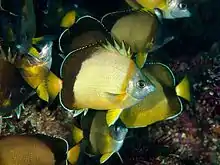Chaetodon nippon
Chaetodon nippon, also known as the Japanese butterflyfish, is a species of butterflyfish found in the northwest Pacific Ocean in the shallow seas around Japan, South Korea, the Philippines and Taiwan.
| Chaetodon nippon | |
|---|---|
 | |
| Scientific classification | |
| Domain: | Eukaryota |
| Kingdom: | Animalia |
| Phylum: | Chordata |
| Class: | Actinopterygii |
| Order: | Perciformes |
| Family: | Chaetodontidae |
| Genus: | Chaetodon |
| Subgenus: | Lepidochaetodon |
| Species: | C. nippon |
| Binomial name | |
| Chaetodon nippon | |
| Synonyms[3] | |
Description
The Japanese butterflyfish is a deep-bodied, vertically flattened fish up to 15 cm (6 in) long. The dorsal fin has 12 or 13 spines and 18 to 20 soft rays while the anal fin has 3 spines and 15 or 16 soft rays. The body is creamy-brown, rimmed with dark brown. The juvenile fish has an eyespot in the region of its soft dorsal fin, but this fades as it grows.[4][3]
Distribution and habitat
The Japanese butterflyfish is native to the northwestern Pacific Ocean, where it occurs in the waters of Japan, South Korea, the Philippines, and Taiwan. It is particularly common around the Izu Islands.[1] With a preference for rocky coastal reef habitats, it has been recorded at depths of between 5 and 20 metres (16 and 66 ft), although it is probable that it also inhabits deeper water.[1]
Ecology
The Japanese butterflyfish is a benthic fish with an omnivorous diet,[5] which includes polychaete worms, crabs and other small invertebrates. It often moves around in large or small groups.[1]
Although many butterflyfish form aggregations when spawning, the Japanese butterflyfish have been observed spawning in pairs.[6] This is one of the few species of butterflyfish whose larval development has been studied. On hatching, the larvae float upside down near the surface, but at 72 hours start swimming and feed on such zooplankton as oyster larvae. By the time they are ready to settle, the butterflyfish larvae are attracted to lights at night, and at this time, their colouring transforms into that of juvenile fish with great rapidity.[7]
Status
This fish has a fairly wide distribution and is a common species, particularly in the Izu Islands. It seldom appears in the aquarium trade and its population seems stable, so the International Union for Conservation of Nature has assessed its conservation status as being of "least concern".[1]
References
- Pyle, R.; Myers, R.F. (2010). "Chaetodon nippon". IUCN Red List of Threatened Species. 2010: e.T165636A6075419. doi:10.2305/IUCN.UK.2010-4.RLTS.T165636A6075419.en. Retrieved 20 November 2021.
- Bailly, Nicolas (2015). "Chaetodon nippon Steindachner & Döderlein, 1883". WoRMS. World Register of Marine Species. Retrieved 4 November 2017.
- Froese, Rainer; Pauly, Daniel (eds.) (2019). "Chaetodon nippon" in FishBase. December 2019 version.
- "Sugoi Sakana Supottoraito: Chaetodon nippon". Reef builders. 2014-12-02. Archived from the original on 2020-04-04. Retrieved 2020-04-04.
- Pratchett, Morgan S.; Berumen, Michael L.; Kapoor, B.G. (2013). Biology of Butterflyfishes. CRC Press. p. 9. ISBN 978-1-4665-8290-3.
- Hughes, R.N.; Hughes, D.J.; Smith, I.P. (2014). Oceanography and Marine Biology: An Annual Review. CRC Press. p. 14. ISBN 978-1-4822-2059-9.
- Motta, Philip J. (2012). The butterflyfishes: success on the coral reef. Springer Science & Business Media. p. 96. ISBN 978-94-009-2325-6.
